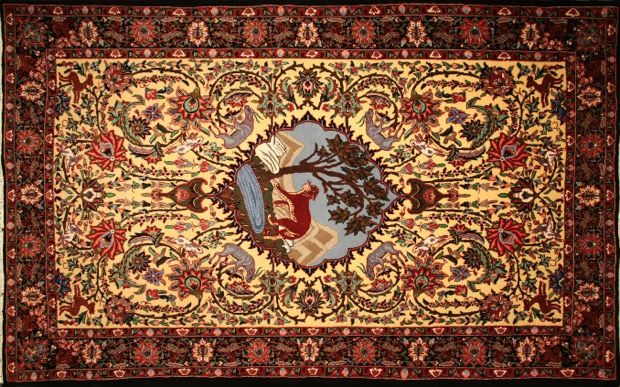-
Persian Oriental Rug
- Size
- Regions
- Material
- Pattern
- ARCHITECTURE PATTERNS
- Geometric
- STRIPPED (MOHARRAMAAT)
- FISH DESIGN (MAAHY)
- PALMETTO FLOWER (MEDALLION )
- HUNTING DESIGN (SHEKAR GAAHY)
- PANEL DESIGN (GHAABY)
- FLOWER POT DESIGN (GOLDAANY)
- TREE PATTERN (DERAKHTY)
- PAISLEY PATTERN (BOTTEH JEGHEH)
- MIX PATTERNS
- ARTICULAR (BANDY)
- Overall Floral Design
- Floral Motif (Golfarang)
- EGHTEBAASY (ADAPTED DESIGN)
- ALTAR DESIGN (MEHRAABY)
- OTHERS
- Color
- Modern Persian Rug
-
Shop by
- Size
- Color
- MATERIAL
- PATTERN
- ARCHITECTURE PATTERNS
- GEOMETRIC (HENDESY)
- STRIPPED (MOHARRAMAAT)
- FISH DESIGN (MAAHY)
- MEDALLION (LACHAK TORANJ)
- HUNTING DESIGN (SHEKAR GAAHY)
- PANEL DESIGN (GHAABY)
- FLOWER POT DESIGN (GOLDAANY)
- TREE PATTERN (DERAKHTY)
- Paisley Pattern (Botteh)
- MIX PATTERNS
- ARTICULAR (BANDY)
- OVERALL FLOWER DESIGN (AFSHAAN)
- FLORAL MOTIF (GOLFARANG)
- ADAPTED DESIGN
- ALTAR DESIGN (MEHRAABY)
- OTHERS
- ROOM
- STYLE
- Regions
- Special Offer
- How to buy
- Guide
Free shipping & Return
money back guarantee
online support 24/7
CALL US + 000 1584 2578
0item(s)
You have no items in your shopping cart.

PERSIAN RUG SIZES
When decorating your living space, choosing the right size and dimensions for your rug is crucial, as it can enhance the overall aesthetic appeal of your room. Woven rugs are gaining popularity over traditional carpets due to their intricate craftsmanship and versatility. Thankfully, unlike in the past, when limited sizes were available, woven rugs now come in various sizes to meet individual preferences and requirements.
For instance, Oriental rugs are available in sizes ranging from 5 x 8 feet (1.5 x 2.5 meters) to 10 x 14 feet (3 x 4 meters). There are plenty of other sizes available in the market as well. Some popular sizes include 4 x 6 feet (1.2 x 1.8 meters), 4 x 8 feet (1.2 x 2 meters), 7 x 10 feet (2.2 x 3 meters), 8 x 10 feet (2.4 x 3 meters), and 9 x 12 feet (2.7 x 3 meters).
Here are some common rug sizes and their corresponding areas to help you make an informed decision for your living space:
- Small rug size: 3 x 1.5 feet (1 x 0.5 meters)
- 3 square meter area rug: 5 x 6.5 feet (1.5 x 2 meters)
- 4 square meter area rug: 5 x 8 feet (1.5 x 2.5 meters)
- 6 square meter area rug: 6.5 x 10 feet (2 x 3 meters)
- 9 square meter large rug: 8 x 12 feet (2.5 x 3.5 meters)
- 12 square meter extra-large rug: 10 x 13 feet (3 x 4 meters)
CARPETS SHAPES COME INTO TWO TYPES
There are two main categories of carpet shapes: Foursquare shapes, which include squares and rectangles with width and length, and circle shapes, which have circles and ovals with a diameter.
Other than these categories, there are different types of carpets, such as those in octagonal shapes or volume carpets, requiring special orders.
Carpets are named and categorized according to their sizes. The dimensions used for woven rugs today are as follows:

TRADITIONAL PERSIAN RUG SIZES
“GHALI”- 6 square meter area rug: 6.5 x 10 feet (2 x 3 meters)
GHALI is an exceptional Persian carpet with exquisite precision and artistic flair. These carpets, crafted from high-quality wool and silk, come in a wide range of sizes, from 2×3 meters to 6×10 meters, and even more significant, with popular options including 2.5×3.5 meters, 3×3 meters, 3×4 meters, 4×6 meters, and 5×7 meters. What makes GHALI carpets stand out is their superior quality, intricate designs, and vibrant colors, all carefully woven by skilled artisans using traditional Persian techniques handed down through generations.
When considering a GHALI carpet, it's not just about the carpet itself; it's about how your choice can transform your space. Your decision to choose the correct dimensions and design is a powerful one, as it can significantly enhance your room's ambiance. It's crucial to consider the dimensions of your space to ensure the rug fits well and complements the room's overall harmony. A too small carpet may appear out of place, while an oversized rug can overwhelm the space. Similarly, the design of your GHALI carpet is not just a matter of personal preference; it's a crucial element in enhancing its visual appeal, depending on the room you're decorating. With traditional floral patterns and contemporary abstract designs, each style adds a unique charm to the overall decor, making your decision well-informed and confident.
By choosing GHALI, you're getting a perfect balance between size and design carpet. This balance is not just a coincidence; it results from careful consideration and expert craftsmanship. With GHALI, you can elevate your home decor and bring a touch of elegance and sophistication to your living space, knowing that you've found a product that perfectly suits your needs.

“GHALICHE”- 3 square meter area rug: 5 x 6.5 feet (1.5 x 2 meters)
GHALICHE is a renowned collection of Persian rugs, each a testament to the meticulous craftsmanship and artistry that goes into its creation. These rugs, available in various sizes from 1x0.7 meters to 2.2x1.4 meters, including larger sizes like four square meters, are not just carpets but masterpieces that bring a timeless appeal to any space.
When considering a GHALICHE rug, factoring in the room's dimensions is crucial. A rug that's too small can disrupt the room's balance, while one that's too large can overwhelm the space. Selecting a size that harmonizes with the room's proportions can enhance its overall aesthetics. At our emporium, we recognize the significance of finding the perfect rug to elevate your home decor.

“PARDEH”- 4 square meter area rug: 5 x 8 feet (1.5 x 2.5 meters)
PARDEHa Size group type of Persian carpet, is not just a decorative piece; it's a cultural symbol deeply rooted in Persian heritage. These finely woven rugs, measuring around 1.8×2.8 meters or 1.5×2.5 meters, with a total area of 4 square meters, are often used as wall hangings, similar to tapestries. The name 'PARDEH, 'meaning 'curtain' in Farsi, reflects its traditional use. These versatile carpets can also serve as tablecloths or decorative throws, adding a touch of sophistication and elegance to any space. Choosing the right PARDEH carpet, considering factors such as size, design, and colors, is a way to honor and appreciate Persian culture.
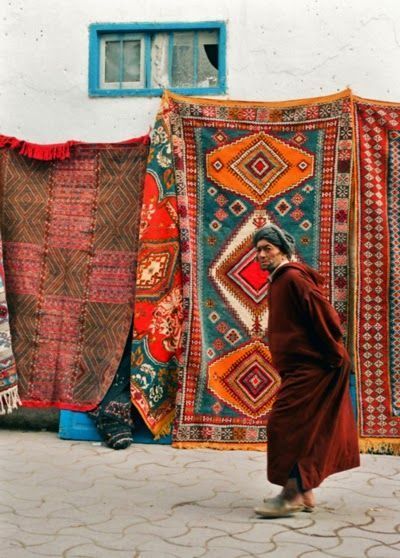
“KENAREH” RUNNER SIZE
Persian runner rugs have been a part of traditional Persian homes for centuries. The runner rug was positioned around the room's perimeter, with a luxurious carpet as the focal point. The runners were primarily meant to safeguard the carpet and the floor underneath from damage caused by regular use. As a result, they were made from high-quality wool, silk, or cotton materials and woven using traditional Persian techniques to ensure durability. The runners were embellished with elaborate nature-inspired designs, including flowers, leaves, and vines. These designs were woven into the runners using traditional Persian weaving techniques, making them a true masterpiece. Persian runner rugs are often used as hallway runners in Western homes, thanks to their ideal proportions. They add an elegant and sophisticated touch to any space while providing the functional purpose of protecting the flooring and reducing noise. Persian runners are not just beautiful; they are also symbols of Persian culture, art, and craftsmanship. Their rich history and intricate designs make them valuable to any home.

“PADARI”- Small rug size: 3 x 1.5 feet (1 x 0.5 meters)
Padari carpets are exquisite Persian art pieces that can add an elegant touch to any home decor. They are approximately 60x80 cm and are mainly used for carpets in front of a door. These small Persian rugs are not limited to use in landings or front doorways alone. Still, they can also be used as decorative accents on tables, chests, or other pieces of furniture. They are usually crafted using traditional Persian weaving techniques, which make them unique and beautiful. Padari carpets are well-known for their intricate designs and rich colours that can enhance the aesthetics of any room. They often feature geometric or floral patterns, detailed borders, and decorative fringe, making them a stunning piece of art. Due to their smaller size, they can be easily manoeuvred around the home. However, it is crucial to consider the overall decor of the space and the size and shape of the area where it will be placed before selecting a Padari carpet. A well-chosen Padari carpet can add colour, texture, and style to any room in your home, making it a worthwhile investment.

“POSHTI” Pillow Rug Size
Persian rugs are a traditional art form, often woven on looms in varying sizes. The smaller version, Poshti, is a versatile piece that adds elegance and comfort to your space. These delicate, small rugs come in sizes ranging from 50x80 to 130x80 or 60x90 centimeters. They are woven like a bag and feature Kilim or velvet material on their backsides, making them suitable for various uses, from a striking accent to a cozy relaxation spot.

“ZARO NIM” 5 x 3.2 feet (1.5 x 1 meters)
Persian carpets, with their rich history, are considered some of the world's finest carpets. However, the quality of these carpets has changed over time. Modern Persian carpets, made after 1960, typically use synthetic dyes and less fine wool than their older counterparts. These carpets often come in two standard sizes: Dozar and Zaronim, which are approximately 200 x 120 cm and 150 x 100 cm, respectively. The traditional unit of measurement used for Persian rugs is called 'Zaro Nim,' which refers to a carpet with an area of 1.4 or 1.8 square meters. These carpets usually range from 1.5 x 1.05 to 1.6 x 1.10 meters in size. However, the dimensions may vary depending on the rug's maker, age, and style.
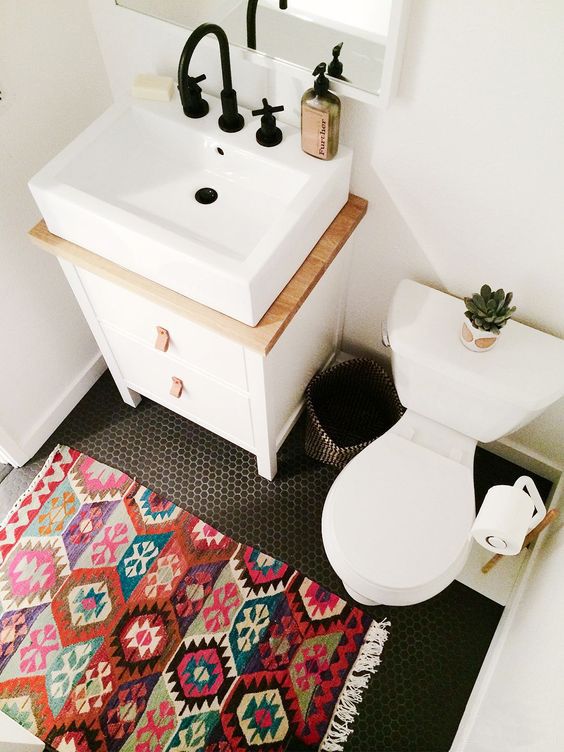
“SAJADEH-EE”
Prayer rugs, typically sized between 2.5 ft × 4 ft (0.76 m × 1.22 m) to 4 ft × 6 ft (1.2 m × 1.8 m), are commonly used for religious practices. However, a specific type of Persian rug called the "Sajadeh," is known for its exclusivity. It is designed exclusively for prayer, made of high-quality materials, and features intricate designs, often centered around the "Mehrabi" motif representing a mosque's prayer niche. The standard size for a "Sajadeh-ee" rug is around 2.10x1.35 meters, but it can vary depending on the design and intended use. The Persian word "Sajadeh" means "worship," while "ee" denotes a cloth that has been woven specifically for this purpose.

“DO ZAR”
The term "Do-zar" is commonly used in the Persian culture to refer to a specific type of rug that measures approximately 7 feet in length (two Zars) and 4.5 feet in width. This rug size is quite popular in Iran and is considered standard for minor to medium-sized rugs. The Do-zar rug is usually found in homes, mosques, or other places of worship due to its versatile size. These rugs are known for their intricate designs and patterns, which showcase the rich cultural heritage of Iran. The Do-zar size can be used for multiple purposes, ranging from small-area rugs to oversized room-sized ones. Over the years, Western consumers have also shown great interest in this rug size due to its adaptability and are increasingly opting for it.

“DO ZARO CHAARAK”
If you are looking for a decorative Persian rug for your home, the Do Zaro Chaarak might be just what you need. This rug is smaller and perfect for decorating smaller areas such as table tops or hallway runners. It is roughly the size of two "zar" rugs combined with a "chaarak" rug. The name "Do Zaro Chaarak" refers to its size and is equivalent to two "zar" rugs combined with a "chaarak" rug. So, if you are looking for a compact and practical rug that adds beauty to your home, the Do Zaro Chaarak might be the perfect choice.
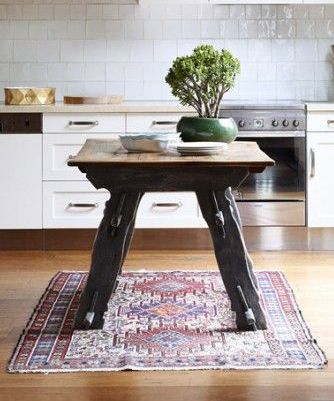
“KHARAK”
Kharak rugs are a type of rug that is similar to "Poshti" rugs but smaller in size. Typically, the maximum length of a Kharak rug is around 100 centimetres, while the standard size is 60 by 90 centimetres. These rugs are often used as decorative pieces or as cushion covers. Due to their smaller size, they are handy for adding a touch of traditional style to smaller spaces.


PERSIAN RUG PATTERNS
Persian carpets are known for their intricate designs that combine floral and geometric motifs. The designs are crafted with high precision, and they rarely feature human representation but occasionally showcase rare animal figures. These designs draw inspiration from ancient and Islamic architecture, particularly tiling, geometrical shapes, and decorative patterns. As the art of carpet weaving evolved, minor categories were created to accommodate changes in the main types of designs. These categories reflect the cultural and regional influences of the weavers, including Persian, Turkish, and Indian carpet designs. Some of the most famous Oriental carpets are celebrated for their exquisite and intricate designs, which have passed the test of time. These carpets are highly prized for their beauty and artistic value, often as cherished family heirlooms passed down for generations.
The most famous ones are:
- Sheikh Lotfol-Allah's mosque
- Mehrabi Koofi
- Masjid Kabood (Blue Mosque, Tabriz)
- Sheikh Safi al-Din Khānegāh and Shrine Ensemble
- Sardar Imamzadeh Mahruq
- Gonbad-e Qabus (tower)
- Shah Mosque (Isfahan)
- Persepolis
- Taq-e Bostan
- Taq Kasra
ANCIENT AND ISLAMIC STRUCTURE DESIGNS
This design category draws inspiration from the tiling, geometrical, and decorative patterns found in buildings constructed during the ancient and Islamic periods. Over time, various minor categories have evolved as the main types have changed. There are many renowned examples of such designs, including Sheikh Lotfol-Allah's mosque, Mehrabi Koofi, Masjid Kabood (Blue Mosque, Tabriz), Sheikh Safi al-Din Khānegāh and Shrine Ensemble, Sardar Imamzadeh Mahruq, Gonbad-e Qabus (tower), Shah Mosque (Isfahan), Persepolis, Taq-e Bostan, and Taq Kasra (Eivaan Madaaen). These designs are aesthetically beautiful and carry historical significance, reflecting the rich culture and artistic traditions of ancient civilizations.






SHAAH ABBASI DESIGNS
The Shah Abbasi Design is a well-known and admired pattern in Persian carpets. It is a cultural symbol of Iran's history and tradition. It is characterized by foliage and animal motifs interwoven to create a garden full of flowers. The design is surrounded by narrow borders and is patterned next to each other in order.
It was first created during the Safavid period and the reign of Shah Abbas Safavid. Skilled designers and weavers were employed during his reign to produce carpets featuring Arabesque designs and everyday flowers. The design is woven by Iranian artisans in many cities, with Isfahan being the most important city for its production.
The pattern is typically woven in Kerman and Qom, with images of animals incorporated into the design. The colours used in Shah Abbasi patterns are one of the main reasons why Iranian carpets are so popular and famous. Typically, dark and light lacquer and peas are used for the carpet background, and crimson and salmon colours are used on the edges. Other colours used in the Shah Abbasi carpet include jujube, indigo, Persian turquoise, green, blue, beige, and cream.
The Shah Abbasi Design showcases the Iranian people's culture and originality. The art and skill of Iranian artists and masters are reflected in the numerous designs and patterns woven into the carpets. These carpets' mesmerizing beauty and uniqueness have earned them many fans worldwide, making them a leading symbol of beauty and art.



SHAAH ABBASI LACHAK TORANJ
The Shaah Abbasi Toranj design is a traditional Persian rug pattern used for centuries. It features a central Toranj, typically shaped like a circle or rhombus, surrounded by intricate designs and patterns. Two "Sar Toranj" are usually placed on either side of the central Toranj. At the same time, four "Lachak" designs adorn the corners of the carpet. These Lachaks are similar in design to the central Toranj but smaller.
However, a variation of the Shaah Abbasi Toranj design does not have the central Toranj and Lachaks in the corners. This variation, known as "Islimy," covers the entire carpet with various floral and leaf patterns interspersed with circular and semilunar lines. This variation is a departure from the traditional Shaah Abbasi Toranj design. It is a testament to the versatility and adaptability of Persian rug designs.
Overall, the Shaah Abbasi Toranj design is a classic and timeless pattern used for various purposes, including old books and leather covers. It is an accurate representation of the rich cultural heritage and artistic traditions of Persia.This type of design doesn’t have the central “Toranj” and those four Lachaks in the corners and the whole carpet is covered with “Islimy” flowers and leaves with a circle and semilunar lines.
SHAAH ABBASI TORREH DAAR
This carpet design is known for its captivating Toranj motif, placed at the centre of the piece. The design also features a series of tresses that surround the motif. What sets this design apart is that the Lachaks are not formed from a quarter of the Toranj motif but are incorporated into the tresses, creating a continuous pattern around the carpet. This unique feature adds an intricate level of detail, making it an excellent choice for those who appreciate the artistry and craftsmanship of traditional carpet designs.
SHAAH ABBASI TASSAROFI
The design in question underwent modifications by adapting Shaah Abbasi's original designs. The alterations mainly focused on eliminating the Lachaks typically present in such designs. The design also incorporated half-Totanjes on the sides of the carpet. It integrated decorative frames and epigraphs seamlessly into symmetry on the sides. These modifications resulted in a more unique and distinct design, setting it apart from traditional patterns and styles.
ESLIMI PATTERNS
The Eslimi design is a famous carpet found in Persian rugs, featuring circular branches among the leaves that form abstract trees. The design is widely used in Islamic arts and is often repeated in form. It is one of Islamic art's three central aesthetic pillars, the other two being calligraphy and geometry. The design represents the underlying order and unity in the natural world, symbolized through unbroken spiralling patterns and limitless branches. Eslimi, also known as Arabesque, is a style of art that involves creating art from foliage patterns. It includes more than just foliage patterns and has many sub-branches, such as Broken Eslimi, Dragon Eslimi, and Snake Eslimi. The smooth flow of various motifs represents harmony, symmetry brings two halves together, and spiralling motifs represent the flow of life. Eslimi art is symbolically significant, representing many core values in the Quran and human culture. Motifs are the individual pieces that make up the overall pattern or artwork in Eslimi designs. These motifs are representations of foliage and vary by region. The motifs are woven together using the three core principles of symmetry, spiralling, and rhythm, which tessellate throughout the piece in ways that represent the vibrations of nature. Arabesque art is used in many ways, including in the designs of buildings, pottery patterns, ornate book headings, and textiles like rugs and carpets.

AFSHAN
Afshan is a distinctive carpet design style that originated in Persia and India in the 17th and 18th centuries. Unlike other carpet designs, Afshan designs are characterized by scattered flowers, leaves, and branches that are not interconnected in a continuous pattern. The term "Afshan" itself means "scatter" in Persian. This design style has been painted with a brush continuously moving from the beginning to the end. Afshan designs have given rise to several sub-branches, each with unique characteristics and features. Some of the popular sub-branches of Afshan include Afshan Eslimi, Line Design Afshan, Afshan Bandy, Broken Afshan, Ansari Flower Afshan, Shaah Abbasi Afshan, Flower Trend Afshan, Floral Afshan, Afshan Animal design, and Afshan with Toranj. Despite the variations in sub-branches, all Afshan designs share the same unique qualities that make them stand out from other carpet designs. These designs are visually appealing and have significant cultural and historical value.

BOTTEH JEGHEH(Paisley Pattern)
The Paisley or Botteh Jegheh is a floral pattern that has been used in the headgear of Iranian kings since the Safavid Empire. The pattern's origin is uncertain, with some theories suggesting it originated in ancient Babylon or is a Zoroastrian symbol of fire. The design symbolizes various things, such as the Zoroastrian holy fire, pine fruit, water drop, cypress, and bird of kindness. The design can be found in Iranian carpets in different forms and sizes, including Botteh-ee or curved bushes. Traditionally, the pattern was used to create high-quality hand-woven Iranian cloth called Termeh, which was used in the costumes of high officials and courtiers. Today, Termeh is mainly used for decorative purposes in essential ceremonies. The town of Paisley in Scotland is where Paisley shawls were manufactured. The shawls were made to supply the growing demand for "cashmere" shawls created by importing patterned shawls made from the soft fleece of the Kashmir goat from India. The shawl designs depicted exotic scenes of people on elephants riding past palm trees. Paisley shawls were mainly worn by men for ceremonies. The original paisley shape was a curving flower with leaves and a stem. Still, it evolved into the shape we recognize today. The paisley pattern shows how weavers translated artistic influences from imported ceramics, documents, and fabrics into their designs. Women in Paisley adapted the traditional design by weaving woollen shawls using Jacquard looms from roughly 1800 to 1850.
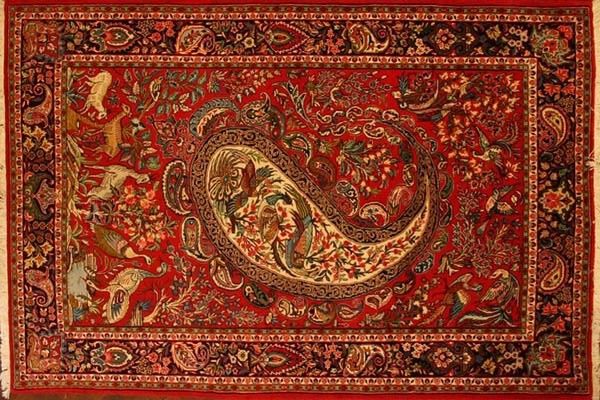
ADAPTED PATTERNS
One of the famous patterns of Persian rugs is the adapted pattern. These carpets are called "Eghtebasi", which means "adopted". This name is fitting because these rugs seamlessly integrate elements from Iran's frontier zones, neighbouring countries, and other global carpet designs. The beautiful fusion makes Eghtebasi rugs unique, showing their versatility and captivating appeal. The Ghafghaazi and Gooblany patterns are noteworthy examples of exquisite craftsmanship among the various designs. The Ghafghaazi design features intricate floral and paisley patterns, highlighted by bold geometric shapes and rich colours. Meanwhile, the Gooblany design is minimalist, with simple yet elegant motifs and an earthy colour palette.

ARTICULAR PATTERN ( BANDY)
Our collection of Persian rugs offers a unique and modern design called Articular. This Bandy pattern showcases the innovation and creativity of Persian carpet-making. The pattern comprises intricate medallions connected by a curvilinear design that resembles the joints of the human body, surrounded by decorative borders and panels with floral or geometric motifs. Our skilled artisans use high-quality wool or silk to hand-knot the Bandy pattern, creating a distinctive and elegant rug for those interested in traditional Persian styles. The term "Bandy" refers to repeating a small piece of the design in length or width on the carpet, creating pieces called "Band Bandy" or "Vaagereh" when joined together in repetition. The Bandy pattern has various sub-branches, including Bandy Eslimi, Bandy ivy flower, Bandy broken pattern, and more, demonstrating the beauty and quality of our handcrafted rugs.
BANDY MINA KHAANI (Articular pattern branch)
The Mina Khaani rug collection showcases a stunning design inspired by traditional carpet patterns from various regions of Iran, such as Kurdistan, Bijaar, and Saavoj Bolaagh. The intricate main border pattern features sprawling vines and blooming flowerets. In contrast, the outer border is adorned with ivory pentagonal lappet forms that project outwards. The exceptional craftsmanship of our skilled artisans from Hamedan, Chaharmahal Bakhtiari, and Ghaenat is evident in their attention to detail in creating each rug. With its elegant and striking design, the Mina Khaani rug collection is a perfect addition to any home decor.
BANDY ISLIMY
Eslimi design is a unique style of Articular (Bandy) pattern rugs that features a complex network of interconnected branches, lines, and forms that seamlessly blend with floral elements such as Khataee or Shaah Abbasi to create a mesmerizing composition that covers the central part of the carpet. These exquisite Eslimi rugs are handcrafted with great care and attention to detail, showcasing our skilled artisans' unparalleled artistry and expertise. We have carefully curated a collection of Eslimi rugs highlighting the highest levels of quality, craftsmanship, and diversity, ensuring that there is something for every taste and style.
BANDY BAAZOO BANDY
Name of this design has been inspired from the bracelets and belts forms, that Iranians used to give them their heroes and athletes in old times and these forms are used to make a continues and uniform design. The frame designs and their paintings were the carpet designers, inspirational hints and by repeating these designs beautiful carpet designs were created.
BANDY KATIBEH-EE
In this type of design polygon frames with floral ornamentations are forming two frames with one flower or connected in a line together.
BANDY SHAAKH GAVAZN HEIVAAN DAAR
The curvy hartshorn is the main basic character of forming the Bandy Shaakh Gavazn Heivaan Daar design.in the core of this type of design, the flowers with their leaves and buds are limited by a design which is too similar to curvy Hartshorne as well as the flowers are mainly covering the carpet course in a symmetry way.
In “Bandy Shaakh Gavazn Heivaan Daar “ design some tiny animals, too similar to gazelle and deer can be found in different part of the carpet and beside the flowers. Around these designs are usually decorated with curly tiny Islimy lines which are embracing small flowers.

DERAKHTY
As the plants and trees design were always too blessed to ancient Iranians, so the carpet-weavers were too concern about it as well, this type of design is still weaving in many parts of Iran but the carpet experts believe Kermaan is where it is originated from.
The main is done by using the branches and leaves in carpet designing, but in this type, it is tried to protect the parallelism between the design and nature. The famous Derakhty designs are:
Derakhty Jaanevary or Heivaan Daar, Derakhty Sabzy Kaar or Aab Namaa, Derakhty Toranj Daar, Derakhty Sarvy and Derakhty Goldaany.
DERAKHTY HEIVAAN DAAR
In this design, some birds can be seen in the middle of the branches and leaves and some animal which is grazing or laying down the trees as well.
DERAKHTY SHEKAAR GAAHY
When there are some hunters on horses or on foot in the course or margin of the carpet, the Derakhty design will be known as Shekaar Gaah.
DERAKHTY SABZY KAAR
If a lake in turquoise-coloured in the middle of the carpet, the carpet design is called Derakhty Sabzy Kaar or Aab Namaa. There is nothing as the complete form of a tree and these are the branches and blooming tree stalk as the main design character.
The “Derakhty Sabzy Kaar” is one of the famous designs which is originated from the “Raaver” city in the “Kermaan” province, about sixty years ago and interred to the beautiful Iranian carpet designs and nowadays, weavers from Kashan, Isfahan, Qom, and Tehran are interested in weaving this type of design.
that must be said, that most of the European know the trees in the designs as a good sign and a reminder of life permanence, prosperity, and happiness.

TURKAMAN OR BOKHARA
The design of Turkman carpets is known as the tribal and designs and the colony people, that are weaved offhand and without any determinate design. The sub-branches of this type of design are:
Turkamany Ghaaleb Yamoony, Turkamany Shaaneh-ee, Ghazaal Goaz (gazelle’s eye), Turkamany Akhaal, Turkamany Chaahaar Ghaab, Turkamany Khourjiny va Ghaashoghy.

SHEKAAR GAAHY
The main character of this style is using the hunt paintings and hunting-grounds in a way that a hunter or a horse rider is hunting a gazelle or any other animal by an arrow and a bow. Sub-branches of this style are:
“Shekaar Gaah Derakhty”, “Shekaar Gaah Toranj Daar”, Shekaar Gaah Ghaabi, Shekaar Gaah Lachak Toranj, and Shekaar Gaah Saraasary.

GHAABI( KHESHTY)
The course of the carpets are divided into numbers of different frames or parts which are sited in continues disciplined rows and each frame is decorated with different flowers or leaves. This style’s sub-branches are:
“GHABBI ISLIMY”, “Ghaaby Qurany Kermaan” or “ Sotouny”
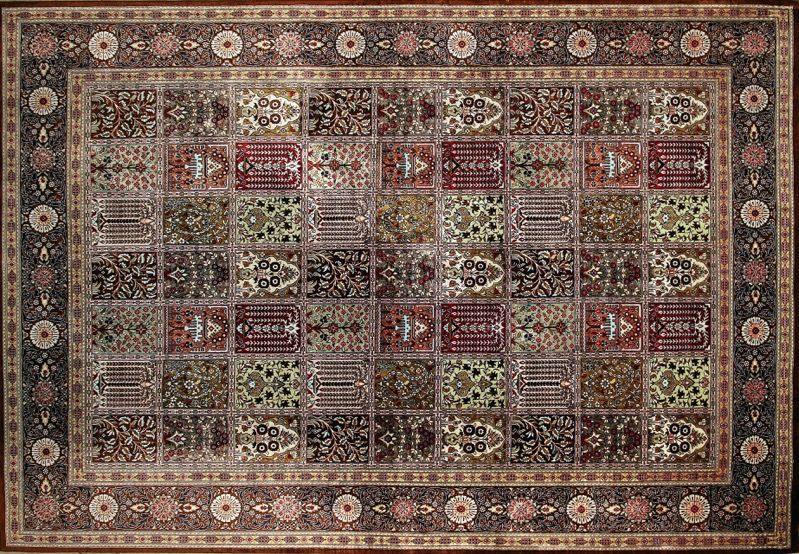
GOL FARANG
All the designs of this group are designed based on natural flowers, especially light colored flower roses, such as yellow, blue and red. Sub-branches of Gol Farang design are:
Gol Farang Bijaar”, “Gol Farang Dasteh Goli “,” Gol Farang Gol-o Bolbol”, “Lachak va Toranj Gol Farang”, “Afshaan Gol Farang” and….
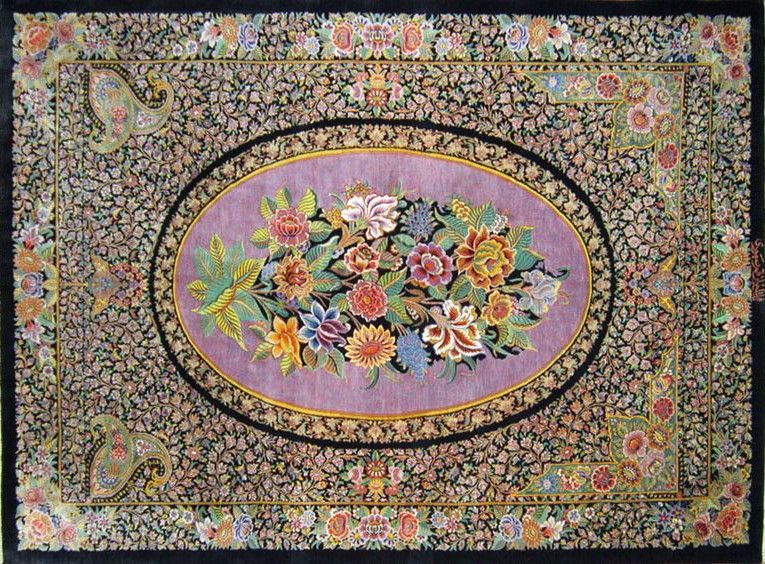
GOLDAANY
Many flowerpots can be found in the Goldaany designs in different sizes, and that’s why this style is called “Goldaany,” in fact, “Goldaan” means flowerpot in Persian, and “Goldaany” means something which contains some flowerpot or is similar to flowerpot.
Sometimes a big flowerpot full of flowers covers the whole carpet, and sometimes some tiny flowerpots are sited around the carpet course in summitry, or they cover the entire carpet in continuous rows. Sub-branches of this style are:
“Goldaany Khaataa-ee”, “Goldaany Do Tarafeh”,” Goldaany Mehraaby”,” Goldaany Saraasary”, “Goldaany Zellol Soltan” (“Golo Bolbol”), “Goldaany Haj Khaanoomy”,” Goldaany Tekraary”, “Goldaany Lachak Toranj” and “Goldaany Yek Tarafeh”.
GOLDAANY ZELL-E SOLTAN
It is one of the sub-branches of Goldaany designs with birds on the sides of the flowerpot instead of handles, and it is full of flowers.
GOLDAANY HAJ KHAANOOMY
It is of the “Goldaany” style sub-branches, which is most famous among the “Ghashaghaa-ee” people, and it is called “ Naghsh-e Nazem” in Shiraz city. The Ghaliche (rug) with this design is called “Nazem Kashkooly”.one of the significant points about this style is the proportions observance and the size and dimensions of the similar repeated objects throughout the carpet.
It is said that the name “ Haj Khaanoomy” has come from a lady called “ Haj Khaanoom Jahaan Aaraa Bee-bee,” who has made such an excellent effort for “Ghashghaee ” carpet(carpet style of Ghashghaee tribal) weaving art.

MEHRAABY
The word “Mehraab” means “altar “ in Persian, and the word “Mehraaby” is referred to whatever looks like an “ altar.” An altar shape is a moving object to carpet designers for this creating this style, those designs which are having this semicircular altar are not having a hunting scene usually, as well as using trees and flowers to visualize paradise, and it is hardly tried to implant the holiness of the altar to the observer as a spiritual place.
The primary key of this style is altering, which can be seen with a hung candelabrum from the altar’s arch, or some trees and flowerpots used as decoration, or sometimes the altar is standing over two giant columns placed on two sides of the altar.

MAHI DAR HAM
It is one of the most famous and current designs in Iranian carpet designs and it mainly comes with a “Vaagireh” ( or Mahi (is the name of a design that is fully covered with the repetition of a small object in the whole carpet) that is repeated in length and width of the carpet.in this design, a rhombus shape is in the middle of the carpet and four other triangles are sited on its four sides and fully covered with “Mahi” design.
“Mahi Dar Ham” designs are famous with different names in different part of Iran and the most important ones are:
“Mahi Heraty”, “Mahi Faraahaan”, “Mahi Zanboury”, “Mahi Kurdistan” and “Zire Mahi”.
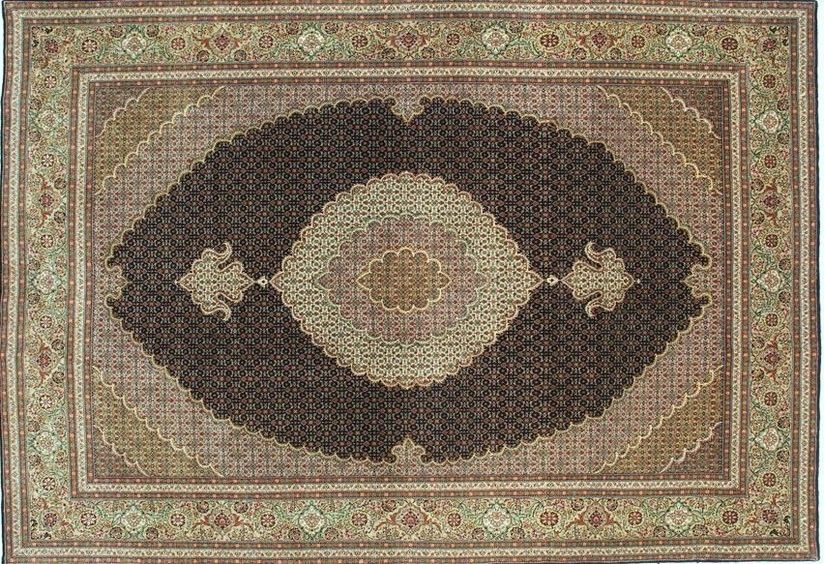
MOHARRAMAAT
The Moharramaat designs have an object from a design, which is repeated in the length of the carpet, and the rug's width is divided into some rows; each row is continued specified color and design from the start till the end, so the carpet is stripped. This design is called Ghalamdaany in some parts of Iran; the sub-branches of Moharramaat are:
Ghalamdaany Saraasary, Gol Riz or Kaf Saadeh and Botteh (means bush) Ba Kaf-e Alvan.

HENDESY
Geometrical shapes are used in this style of design, and that’s why it is called Hendesy, which means Geometrical in Persian. Usually, the lines are angular, and they don’t move in arches and circles .main sub-branches of this style are :
Hendesy Bandy Ghaabi, Hendesy Toranj Daar, Hendesy Moharramaat, Hendesy Lachak Toranj (Shaakheh Shekaste), Hendesy Kaf Saadeh, Hendesy Khataee, Hendesy Setareh ( Moozaaeek), Hendesy Khaanoom Shiraazi and Hendesy Joshaghaany.

EELY
This is one of the oldest Iranian carpet designs, and native carpet weavers' minds created the designs. Nature and their living environment are reflected in the most straightforward way in their carpet designs; they are not following the traditional design and have their beauty. The carpet designers have transferred this style from one region to another to be admitted from the most western part of Iran to the most eastern part of Iran. This style sub-branches are mainly from those regions where the designs were circulated from the beginning, or they are in the name of the people who had significant influence in the area or ordered the design. The old and famous characters of this group are:
Heibat Loo( related to Fars province), Ghashghaa-ee Botteh, Afshari, Khaatoony, Ardebil, Mezloghaan, Khamseh, Saaveh, Tafresh, Heriss, Goraavaan, Zanjaan, Meshkin Shahr, Bakhtiaary, Kurdy, Yelmeh, Gabbeh(Khod Rang),Sistaan , Ferdows,Saalaar Khaany, Yaghoob Khaany, Sang Chooby, Ali Mirzaa-ee, Jaan Beigy, Jaanamaazy, Javeen, Moosaa Abaad, Balochistan, Veis, Gharjeh, Seneh, Dasteh Gol.

TALFIGHY
In addition to mentioned designs, every one of them has its own specified name and history, some other designs are created out of the composition of two or more methods together, and the word “ Talfighy” means composed of two or more objects together. Sub-branches of this style are:
Shaakheh Pich Toranj Daar, Selseleh-ee Toranj Daar, Talfighy Lachak Toranj, Goldaany Band Islimy, Talfighy Toranj Daar, Talfighy Toranj Toranji Kaf Saadeh, Talfighy Lachak Toranj Kaf Saadeh, Talfighy Lachak Toranj Sabzy Kaar Kaf Saadeh and Talfighy Bandy Dasteh Gol.
GOL FARANG DESIGNS
The main critical elements of this style are red roses with regularly five or eight rose leaves in a bunch of flowers which are repeated in the whole carpet.
Sometimes Gol Farang is designed in the flower pot, and its other types' names are:
Gol Farang Bijaar, Bazoo Bandy, Dasteh Gol, Mostofy and…..
GOL FARANG MOSTOFY
The title “Mostofy” was honored by kings to their functionaries. This style has mainly common in the cities of Arak, Tabriz, and Bijaar, and it’s most probably referred to as one of the Mortifies from the Qajar Period; basically, this style is formed by some rhombus which is combined with “Gol Farang “ designs and decorative branches or even sometimes Islimy designs are used for more decoration.
GOL FARANG LACHAK TORANJ
In this style, the central "Toranj" is surrounded by red roses and "Gol Farang" flowerpots, and the recognizable difference between the design and the color of "Lachak," from the main base has created an elliptical shape right in the center of the carpet which the central "Toranj" is bragging in it. Wide margins in this style reflect the designs and primary colors of the basement.
